Rick: Yes, we have been enjoying the Ya Ha Tinda Tatonka. They have been entertaining us to say the least. We kept them separate for a couple of months, but then turned them loose with the colts and everything seems to be cohabitating just fine. It’s all new to us! These bison are not the wild bison that will be reintroduced into Banff National Park. These four girls are here solely for the horse training purposes and will remain here. We are not concerned about overgrazing. They will remain in the Jingle Pasture which is fenced to keep them in and we will feed in the fall and winter.
Rod: What about the elk situation now. They have fluctuated a bit in your time. There are a few less now, is that right?
Rick: Yeah. They have been on the decline for quite a few years. You’d read back in history in the early 1990s guys would say there was 2500 elk here. Now, whether that was true I don’t know for sure. When we came here there were about 1200 head and it declined to a point where there was about 350 head. Through some information that we have learned from the researchers, if an elk herd has a calf survival rate in the first year of up to 25 percent, then the herd is growing, and this herd has been. According to the researchers this herd has a 25 to 27 percent elk survival rate. That has brought our herd back to – I think the count last spring was around 500 head so it is going in the opposite direction again which is nice because with a 10,000 acre ranch and our horse herd down we need the elk and the deer to graze this land off or it’s a fire hazard. And lots of other problems can come of it, so to see the elk come back up more than they are now – the 500 head mark – so we’ve been told – we’ll see how that progresses. I am hoping that it will keep going upwards.
Rick: (showing photos These are of photos of some of the three year olds that the boys are just starting. This colt there (being ridden in the arena), Tom has probably been on him about 30 times now so the colt is starting to learn how to stop his feet from being all tangled up a bit and he moves around a little better. It is nice to watch.
Rod: Is that Tom McKenzie?
Rick: Tom has been with us about 8 or 9 years now. And Rob has been here quite a bit longer than we have.
Jean: He has been here about 18 or 19 years now. (Robert Jennings started work as a horse trainer (ranch hand) at the Ya Ha Tinda Ranch on January 7th, 1999. Tom McKenzie started on November 5, 2007.)
Rick: We are always joking here…we are a contingent of the Ya Ha Tinda….we are probably the oldest bunch that have lasted a long time. We all love the place so much they are going to have a hard time making us move so they might as well keep us riding. (laughs)
Rod: You’ve done a lot to keep the operation mobile and dynamic. I know from what I’ve seen it is certainly a demanding job being the manager here. Looking at all the different aspects besides the horses… that is just amazing. You have certainly done a great job of keeping the place an important asset for parks. That is nice to see a kind of renewed interest in horses and keep the horse program going. A lot of us get fearful of times changing and parks going different directions. It sounds encouraging that they are planning on utilizing and keeping the horse program going.
Rick: Yeah.
Rod: I guess that is a modern outlook from parks’ perspective. You occasionally get folks from Ottawa or whatnot to come out. I am not sure of who is in charge of what now.
Jean: Neither are we. (everyone laughs) It changes.
Rod: That is a demanding aspect too – to accommodate people who are out here for what ever reason with the department and hopefully get an appreciation for what you have here….and will continue to have.
Rick: We encourage anybody that doesn’t understand what the ranch is (about) to come up, especially the higher people in Parks Canada itself because it is hard for them to administrate us if they don’t really know what we are, right. So, we enjoy having them here to show them the gem that parks Canada owns in the Ya Ha Tinda. And it is nice for them because they go back and they understand a little more about what our needs are and what we asking for and things like this if they actually physically have been on the place and seen it themselves and not getting it second hand. So we encourage anyone who is interested. We were very lucky when we had Mr. Latourelle and some others out here a few years ago and it lifted our profile.
In 1997, Mr. Alan Latourelle was appointed Assistant Deputy Minister, Department of Canadian Heritage. He then joined Parks Canada as Director General, Western and Northern Canada, where he led an operational service delivery unit of more than 2000 employees that serviced 12 million visitors annually. He ensured that federal government objectives were achieved by developing sound public policies and service delivery approaches within a multi-stakeholder environment. In this environment, Mr. Latourelle led national policy initiatives that are considered landmark decisions for the protection of national parks. They resulted in a legislated framework being established to limit commercial growth in the six national park communities. He also led the development of alliances with First Nations. In addition, he guided complex federal/provincial negotiations in support of the establishment of new national parks and national marine conservation areas. In 1999, Mr. Latourelle became Chief Administrative Officer for the Parks Canada Agency. He gave direction on developing policy initiatives that resulted in limits to growth being established for outlying commercial operations and some of Canada’s most important ski resorts. He also led federal/provincial negotiations that resulted in an agreement with elected representatives of the Town of Jasper for the community to assume responsibility for municipal services.
Rod: And you have had several politicians – Rona Ambrose and some of these senior bureaucrats.
Jean: Well, it was Mrs. Harper on a hiking trip starting from here. She does an annual hike with her friends every year and they backpack and they tent and she cooks everybody’s meals over an open fire. So Rona was on a trip with her. And when they got back here we showed them around; gave them a little tour and Rona and her partner came back with the kids the following weekend and stayed in the little bunkhouse. And since then they’ve been out a few times. It has developed into a little friendship too. But she absolutely loved this area and so did Mrs. Harper. And I am thinking that we should send Prime Minister Trudeau a letter and a picture because Rick guided Pierre Elliott (Trudeau) when his boys were all little on a pack trip. So it would be kind of cool because we have picture of that. We could send him that and an invitation saying “You probably don’t remember your guide of that time. He is now managing the Ya Ha Tinda Ranch which you own.”
Rod: I think that would be a great idea.
Jean: Yeah, I can’t hurt us.
Rick: They were an interesting family and they were fun when we did guide them and it would be interesting to see if he would be interested in coming to see this place or not.
Rod: Hopefully he would be able to find some time to visit the place.
Rod: When did Banff started administering the Ya Ha Tinda rather than Regional Office. How is that working?
Jean: That was long before we came here. I think was even before Johnny (Nylund) was hired; I think it was Banff that hired Johnny.
Rick: Perry Jacobson was involved when the changeover occurred, and it was long before we were here – and even Johnny I believe. But I like the idea of having our Banff Resource Conservation Manager as my immediate boss in Banff because he understands the program. With Calgary, I am not saying a thing against them, they are fantastic too, but they have not made a trip down the trails on the back of a horse and understood what the ranch really means and what we need and what we can do. And we get huge support from Banff. In every aspect, with our financial stuff and…
Jean: Especially with communication…. if we need some advice on something or they need to know something our communication is very, very open with Banff and that is with all aspects…in maintenance, in communication, in any staff issues, whatever. The lines of communication have always been there.
Rod: You have a small budget that is kind of controlled by Banff?
Rick: Yeah, oh yeah. It comes out of the Banff Field Unit. It has changed, it is really probably, in the long run….well Jean could answer this better than I can. She understands the finance end of it better than me.
Jean: The capital budget no longer exists. Our operating budget is probably the same as it was when we got here…it is exactly the same actually, except that there are certain things we are not responsible for any more. Like the communication cost was $12,000 a year for one satellite phone. Now it is all shared services and it doesn’t reflect on our budget. So that is one cost we don’t have. There are others, generator costs, maintenance costs, etc are now picked up by “Assets” in Banff and are not under our budget now. The contracts, with Alberta Parks (for example), that revenue gets credited to our budget. So we can take that budget and stay within that budget whereas, you know, twelve years ago you were commonly $30,000 over budget.
Rick: The Field Unit would have to absorb that somehow.
Jean: It is more transparent now. For sure.
Rod: That is good here.
Rod: We talked briefly about the radio and communications systems and how that has changed so dramatically but it is pretty up-scale by the sound of it. It is pretty up-to-date with satellite systems.
Jean: Well, we are totally “plugged in”. So, all the changes within Parks Canada, with timesheets, with leave requests, everything to do with Pay & Benefits or H.R. (Human Resources); is on-line now. We are responsible and contribute that way as well. So, it has set us up with technology and with Parks Canada – with Banff – you know, we are not way out here and been forgotten. It has created a lot more work…a lot more work!
Rod: But you are not isolated in that sense.
Rod: Jean, your job was cut back over time and you now send e-mails signed “Not so silent partner”. Tell us about that.
Jean: That was meant as a private joke with tongue in cheek. I was the only one affected at the ranch by the cut backs. I was cut back to .25 and it was decided that I would get paid for half days for six months, then be laid off for 6 months. Of course, the job didn’t go away, just the paycheque, so I jokingly signed a few emails to select people, “Not so Silent Partner” in reference to Ann Dixon’s book about Warden wives in the backcountry.
Rick: Like Jean says, now it’s gone from full-time…we need at least one person fulltime almost, in the office any more because there is so much more that we do that somebody else used to do. And the system has changed so, yeah.
Jean: It is a lot more time consuming.
Rod: Times change and you are able to adapt to it.
Rod: How do they justify keeping the ranch?
Rick: I can’t speak for “them” as I don’t know who they are. But in my opinion the ranch is justifiable for many reasons: Training centre for Parks Canada horses, horsemanship training for Parks Canada staff, revenue generated from other government departments such as DND and Alberta Fish & Wildlife and Alberta Parks; public appreciation, historical, ecologic al and cultural value; a buffer to Banff National Park; a wildlife research centre; a staging area for bison reintroduction.
Rod Do you still use diesel generators for power supply? Is there any chance that the generators will be replaced with electricity from a power company?
Rick: Yes, we still use diesel generators. There is on-going research into alternative power supply and power lines have been included as an option.
Rod: Let’s talk a little bit about the road. You mentioned that since the flood a few years back the road has become even more dependable and they are working on the road constantly to improve it. And of course with the volume of traffic that you are seeing now, the road is more reliable than it was in the past.
Rick: Yeah, well the flood of 2013 was pretty devastating for us. Not compared with the rest of Alberta, but it was pretty devastating. We lost the road in 2005, 2011 and again in 2013. The road used to be just culverts and so when we had one of these flood events, we’d lose the road for quite a length of time until people could get in and repair it. In 2013 we lost it quite badly and we lost it twice farther out (from the ranch) that we didn’t even know about, plus a side of a mountain slid down and buried the road. So we were quite isolated. I heard the weather change in the middle of the night and by 6 am the bridge over Bighorn Creek had water flowing about a foot below the bridge. Half of the campground was already completely under water and we started moving people up to the north end (of the campground) and then we just got them partially moved and we had a bit of a berm built to keep the ground from flooding during the winters and that washed out and all of a sudden two-thirds of the campground was up to your waist in raging water. It was unbelievable. It just about washed away some horse trailers. We managed to get ahold of them and get them pulled up on high ground. We had a pretty expensive hay stackyard down here – we had big $300,000 motor homes and 5th wheels and all kinds of stuff parked there for a while. But ….
Jean: Once the bulldozer got in and made a trail anyone with a reliable vehicle for that would take other people and their horses, if they didn’t have a vehicle that they thought they could get through with. So they commuted out in a convoy behind the bulldozer so that if there was a problem the bulldozer could pull them out. And, yeah, they came back two-weeks later and picked up their vehicles and their motor homes.
Rick: Clearwater County has always been super good to us whenever there is an emergency like that and they’ve been here a lot of times over the 13 years we’ve been here. But they came in and they finally said, “Enough is enough!” and they cleaned up Eagle Creek and the old dry wash and put in bridges, expanded the road and doubled the width of the road all the way out, which was huge because some of these big outfits trying to pass on these small corners was pretty scary stuff. So now Parks is actually going to work on the road from the East gate to the yard this year….hopefully, this year. And it will probably go through the middle of our jingle pastures below the buildings here. The reason for that is that when we originally going to move it over from the existing road we ran into a lot of native artifacts and things like that and the archeologist needed to have time to probably look at that. So this is the best (option) as the roadbed had already been disturbed that they will be rebuilding on now. It is probably the best scenario for what we have. (John Nylund recalls that Earl Hayes, while employed at the ranch, built the road across the Bighorn Pasture in about 1976. Earl used a D-4 caterpillar, a dump truck and the ancient road grader that now sits on display in Parks Canada’s compound in Banff, to complete the task. Gordy Patterson, who also worked at the ranch at the time jokingly gave Earl the nickname “Mannix Construction”. )
Jean: This year they’ve …. The existing road is sloughing so badly underneath the road that we had to move it over. And then from the Bighorn to the East gate they will just improve that road and we are not sure what their plans are with that. We heard that they are going to cut down that steep hill and bring lots of gravel in and do some major work on that road.
Rod: Have the archaeologists had a look at that yet?
Jean: On that road? I am not sure.
Rick: No, I don’t think they have. They’ve looked down below by the campground and stuff like tht but not out on the road itself
Rod: There are so many artifacts and archaeological resources here it is pretty hard to …
Jean: Yes, it is pretty hard to find any place that can be disturbed.
Rod: The Centennial ride in 2009 was a tremendous part of the anniversary of the Warden Service held in Banff. A lot of the older wardens did the ride from the ranch to Banff along the Cascade Fire Road. That was a pretty good experience for a lot of people who sure enjoyed it I think. I wish I’d been able to be a part of that but I was too busy helping to organize the other end of it.
Jean: I think that ride was very important to everyone who participated. And, from the response on Banff Avenue when we rode in, I think it was important to the whole warden centennial. The response from all of the people watching was emotional you know. And I think that everybody knew that the warden service was forever changed. This was a way to show the pride for a job well done. The feelings and the emotions and the story telling and everything that happened on that trip was very up-lifting and I think that we felt it a real privilege to be along on that ride because we felt everything that everybody else felt. I felt it was really important to get some closure on that change.
Rod: It is nice to hear that because I think a lot of the organizing that went into that. A lot of us could not participate because we were organizing on the other end. From those that I talked with that made the ride, they had that feeling of pride you know. The former warden service – the first 100 years – things have changed dramatically but all is not lost I think that there is still some hope that many of the good traditions will be carried on. That was a tremendous event and people who were related to the warden service got so much enjoyment out of the visit there. Hopefully, we will have a similar response next year when the ranch reaches its 100th year anniversary.
Rick: We are looking forward to that because I believe that this is something that anybody who can get here should come to. It is something that we won’t turn 100 years again in our lifetime. So they’d better be coming and enjoy it….make sure their name is on the list.
Rod: It is nice to get together again to visit with old friends and to recognize the pretty significant aspect that the ranch has played with Parks Canada.
Rod: What do you foresee as the future of the ranch? Who will take over? You mentioned that it is difficult to find people with skills to train horses for the backcountry (no one seems to get out of the arena to expose the horses to trail conditions).
Rick: I don’t think I can forecast the future of the ranch. I do think that a horse and rider training facility must be the first priority. It would be great if Parks Canada could see the need for an upgraded facility in the form of an indoor arena, but regardless, it is essential that the horses provided to Parks staff to monitor and patrol the backcountry of our mountain parks, be gentle and dependable and that means hours of training, winter and summer. The future also should, and undoubtedly will, include wildlife research. This may or may not include horse use, depending on the project, but the horse and ranch staff will need to contribute. Parks Canada has committed to a minimum five years in the reintroduction of bison into Banff National Park. The Ya Ha Tinda will be the staging area for much of this project will have the need for horses to travel in the backcountry to monitor the bison’s progress and movements. The person who takes over the management of the ranch needs to have experience with horses and livestock, public relations, organizational skills and needs to be flexible to handle “the unexpected” at all times. But the next Ranch Foreman will also need computer and communication skills to keep up with the rapidly changing technology which is applied to everything we do now.
Rod: Well, I think that has answered most of my questions. Is there anything else you want to share with us? You must never get tired of the view.
Jean: No, we never tire of it. And wherever we go from here nothing will match this. That is why we will stay as long as we are capable.
Rick: All the people in the (Park Warden Service Alumni Society) too Rod. You guys had that feeling of a job well done. And, all of the people who have worked here at the ranch. You look over the (Ya Ha Tinda staff) list in the Historic Display and how many people worked here and it is pretty amazing that everybody has that same feeling about the place and the service. So it is really good.
Rod: It has a really family type feeling here. This place kind of ties everything together. The people who have worked for parks are pretty dedicated. They don’t work for parks for the money involved. It is always a love of the lifestyle, particularly the horses. I know it has made an impression on me over the years to be able to work for Parks Canada and enjoy those aspects of it. We can talk about negative things but overall it has been a positive experience and this place kind of speaks to the whole idea in my mind.
Jean: We are pretty grateful to have the opportunity to spend a good part of our life up here, especially later in our life. We just could never have imagined living up here.
Rick: For a cowboy and horseman it is an amazing feeling to work for an outfit like this where people care whether you get hurt or what happens to you, or people appreciate what you do for them and the ranch and the horses and that kind of thing. It is a wonderful place to be.
Rod: Thank you for taking the time to talk to us. We are all looking forward to the publication of the book The Ya Ha Tinda: A Home Place which Kathy Calvert is writing on behalf of the Park Warden Service Alumni Society.
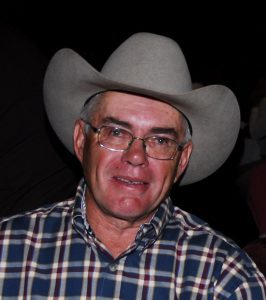
Rick Smith, Ya Ha Tinda Ranch Manager
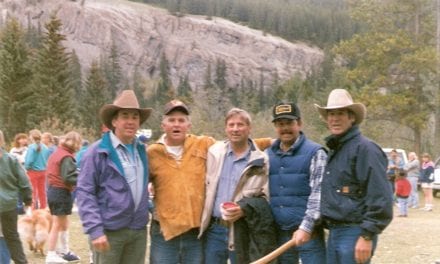
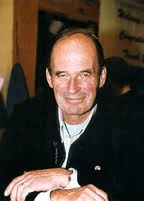
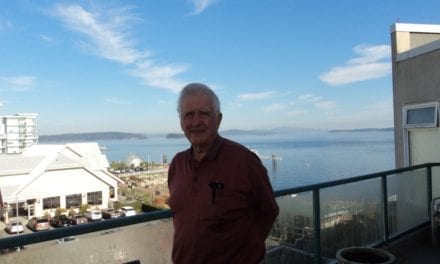
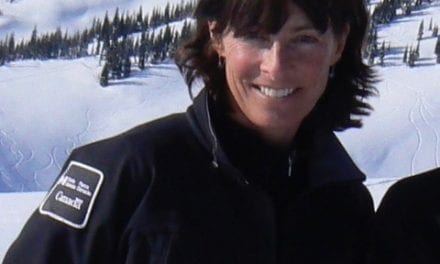
Rick Smith please contact me, scot hall